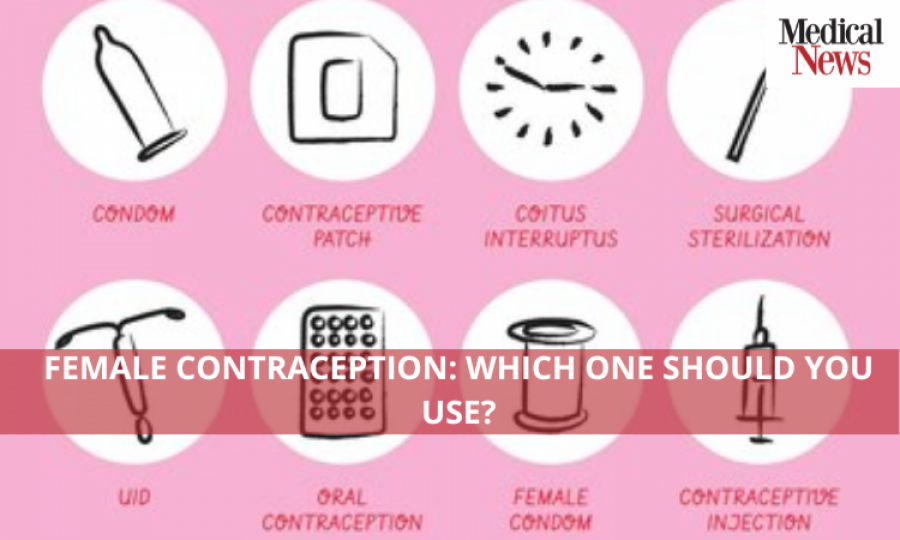Female contraception: Which one should you use?

When selecting the most suitable contraceptive technique, many aspects need to be considered. These criteria include safety, efficacy, availability (accessibility and price), and acceptance. Voluntary informed choice of contraceptive techniques is a fundamental guiding concept, and contraceptive counseling, when appropriate, could significantly contribute to effective contraceptive methods.
In selecting a method of contraception, dual protection against the simultaneous risk for HIV and other STDs also should be addressed. Although hormonal contraceptives and IUDs are very efficient in preventing conception, they do not protect against STDs, including HIV. The article aims to list and explain all the possible female contraception methods that could be used for birth control.
IUD: Intrauterine contraceptive device (IUCD or ICD) or coil is a tiny birth control device that is put into the uterus to prevent pregnancies, Long-acting reversible birth control, such as IUDs, is an option. IUDs are safe and effective for teenagers and women who have never had children. Even after long-term usage of an IUD, fertility recovers quickly.
Oral pills: Oral contraceptives that include estrogen and progestin are often referred to as "the pill." A doctor has prescribed it. Every day at the same time, a tablet is taken. For women over 35 with a history of smoking, blood clots, or breast cancer, a doctor may advise against using the pill to prevent these conditions from recurring. The typical failure rate is 7%.
Hormonal contraceptive ring: Progestin and estrogen are released when you wear the ring. The ring is inserted into your vagina. You take the ring off when you get your period and put on a fresh one for three weeks. The typical failure rate is 7%.
Sponge: An anti-spermicide sponge is inserted into the vagina and positioned over the cervix. When appropriately used, the sponge may stay up to 24 hours in the vagina and should be removed and thrown away after 6 hours after the final act of intercourse. Women who have never had a kid have a failure rate of 14%, whereas women who have had a baby have a failure rate of 27%.
Cervical or Diaphragm cap: The cervix is protected from sperm by these barrier techniques inserted within the vagina. Diaphragms are flattened into the form of a shallow cup. Anatomically, the cervical cap has the form of a thimble. Spermicide is injected into the testes before sexual contact to prevent or destroy sperm. Because diaphragms and cervical caps exist in various sizes, you should see your doctor for a good fit. The Diaphragm has a typical failure rate of 17%.
Spermicides: There are various products on the market that destroy sperm, and they come in various forms. Spermicides may be used in conjunction with a male condom, Diaphragm, or cervical cap to protect against unwanted pregnancy. They're available at your local pharmacy. The typical failure rate in everyday usage is 21%.
Condom: Designed specifically for women, the female condom helps to prevent unwanted sperm from entering the body. Lubricant is included in the packaging and is sold at pharmacies. Use failure rate: 21%, and it may also prevent STDs.
The bottom line
Oral pills, implants, injectables, patches, vaginal rings, intrauterine devices, condoms, male and female sterilization, lactational amenorrhea techniques, withdrawal and awareness-based methods of contraception are some options that are available today. There are a variety of systems at work here, each with varying degrees of success in avoiding unwanted pregnancies. However, discussing and consulting the issues with the gynecologist is suggested before deciding.
Trending
Popular
Sindh pledges vigorous action to prevent poliovirus transmission
-
PMA stresses health equity on World ...
04:08 PM, 9 Apr, 2024 -
Dow University’s new rabies vaccine ...
12:18 PM, 28 Mar, 2024 -
IRD role lauded in advancing ...
02:53 PM, 12 Mar, 2024 -
Over one billion people worldwide ...
09:48 AM, 5 Mar, 2024




